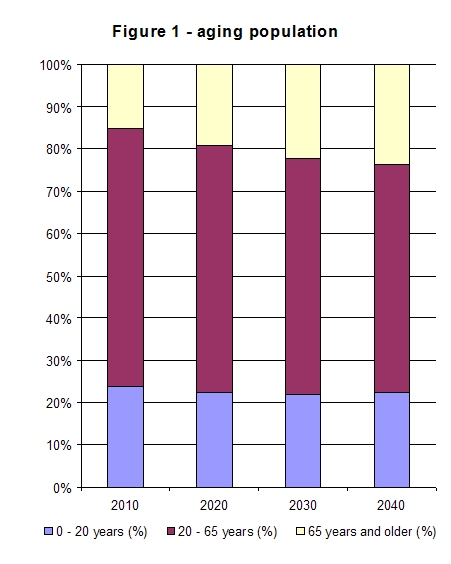Difference between revisions of "Aging population"
| Line 31: | Line 31: | ||
- A global decease (certain flu) could attacks the weaker people (the elderly) | - A global decease (certain flu) could attacks the weaker people (the elderly) | ||
- Population of developing countries | |||
==Paradigms:== | ==Paradigms:== | ||
Revision as of 00:53, 6 March 2007
Description:
The average age of the population in Western Europe will increase significantly in the coming decades. Figure 1 gives the essence of the problem in the Netherlands (Source: Centraal Bureau voor de Statistieken - CBS).
The 65+ population in the Netherlands from 2010 to 2040 is expected to grow from 15% to 24%, whereas the 20-65 population is expected to decrease from 61% to 54%.
The same trend can be observed in most of Western Europe.
Aging population is a driving force, which, for example, is driving Europe to accept Turkey into the EU. With the improved health care, the population of the world is living longer, which means that the world needs more resources to support this growing part of the population. The birth rate however is diminishing and resources are therefore limited and scarce.
High expecation is placed on new technological innovations to provide solutions for confronting the problems caused by aging population.
Enablers:
- Technogical advances in medicine
- Better living conditions in the Developing world
- More health awareness
- Better food quality
- More hostital beds (from 1994-2001, the number of hospital beds increased with 78%)
- A pandemic flu might strengthen this, since recents deathly victims of this flu were in the age range of 10-40 years
Inhibitors:
- Extending the retirement age another 10 years so people will have to work more & retire later
- A global decease (certain flu) could attacks the weaker people (the elderly)
- Population of developing countries
Paradigms:
There has been enormous concern about the consequences of human population growth for the environment and for social and economic development. But this population growth is likely to come to peak and then decline in the foreseeable future.
In order to maintain our current 'care society', an increase of tax payment and pension payment will have to be implemented. It is therefore doubtful whether the current care society can be maintain.
Experts:
- United Nations
- US Department of Health and Human Services
- Centraal beheer voor de statistieken (CBS) for Dutch figures and trends
Timing:
Improving on earlier methods of probabilistic forecasting, here we show that there is approximately 85 per cent chance that the world's population will stop growing before the end of the century. There is a 60 per cent probability that the world's population will not exceed 10 billion people before 2100, and around a 15 per cent probability that the world's population at the end of the century will be lower than it is today. For different regions, the date and size of the peak population will vary considerably.
